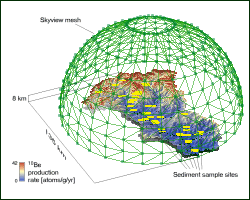GIS has evolved into a full-featured environment for a range of modeling
approaches to analyze and predict the behavior of complex, spatially-
and temporally-varying systems. Given data and empirical or analytical
rules for system behavior, GIS can be used to implement models predicting
the evolution or expected state of the system due to the process(es) in
operation.
Modeling: PredictiveThe intensity of radiation of any kind (e.g., light, cosmic rays, etc) at the earth's surface can be a function of many factors, including the orientation (slope and aspect) of the surface, the elevation (or thickness of absorbing atmosphere above the point), and the amount and direction of total skyview visible from the surface. Although specialized software exists to perform such calculations, we have used off-the-shelf GIS and spreadsheet tools to compute the net flux at every point (raster cell) on the surface.For this application, we computed equal-flux sectors in the sky hemisphere, accounting for the non-uniform flux from different parts of the sky, then used standard GIS visibility analysis to determine total incoming flux at each point on the surface. These values were then adjusted in a raster modeling framework to acccount for surface orientation, elevation, and latitude, and to convert from radiation intensity to cosmogenic isotope production rates. |

